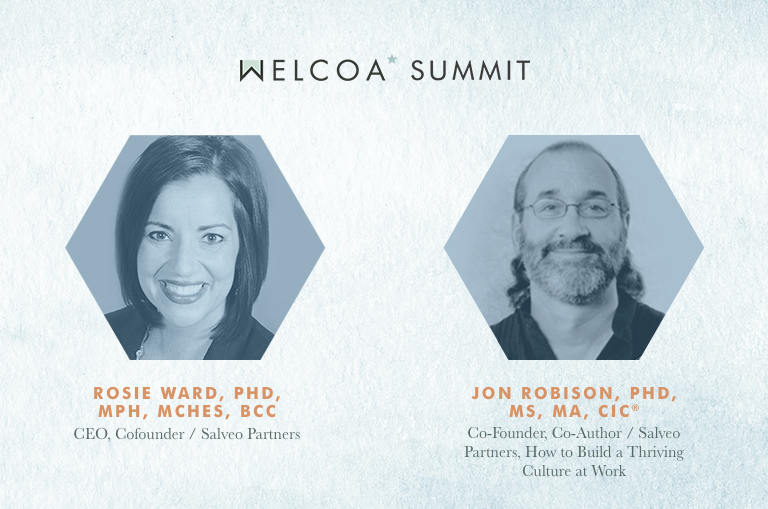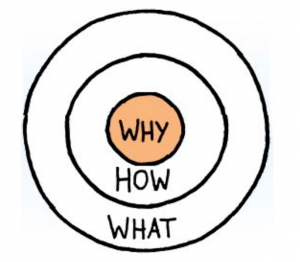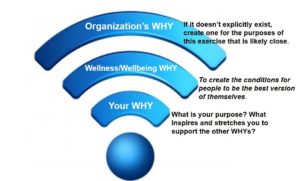It should come as no surprise that the spaces we occupy every day have a huge impact on our overall wellness. The Environmental Protection Agency and Vancouver Coastal Health report that Americans and Canadians spend about 90% of their time indoors. But what about the time we spend outdoors?
Your Welcoa membership has expired.
It’s Time for Employee Wellness/Wellbeing to Reconnect with Our WHY
by Rosie Ward & Jon Robison of Salveo Partners. See Rosie & Jon at the 2017 WELCOA Summit
In his best-selling book, Start With WHY, Simon Sinek states that great leaders are able to inspire people to act by providing a sense of purpose or belonging; they create a following of people who act for the good of the whole because they want to, not because they’ve been manipulated using fear, peer pressure or incentives. Great leaders start with WHY.
Starting with WHY includes following the pattern of the Golden Circle:
- WHY: is a purpose, cause or belief that is about our contribution to impact and serve others.
- HOW: includes your Core Values (what makes your organization unique, your differentiating value proposition, not “permission-to-play” values). It is only through the discipline of HOW and being true to your Core Values to guide every decision you make (including holding the organization and every person accountable to these guiding principles) that you can actually realize and live your WHY.
- WHAT: is simply what you do – the products and services your organization provides, or, for individuals, your job titles or roles.
Every organization and individual knows WHAT they do. Very few know WHY they do it and have the discipline of HOW to bring their cause or purpose to life. The WHY is a belief; HOW are the actions you take to realize that belief. Both should remain constant; what evolves and changes over time is the WHAT we do to realize the WHY. And it should evolve, because the world is constantly changing.
Think about how we typically communicate. We speak about our organizations in terms of WHAT we do and even ask people, “What do you do for work?” – We speak in terms of function. This is incredibly limiting. For example, Kodak was an industry leader but identified themselves via their WHAT; they were a film company. In holding tight to that identity, they put themselves out of business…even though they invented the digital photography technology. Imagine if instead they held tight to their WHY (which would’ve probably been something along the lines of, we help people preserve their memories)? Their WHAT would have evolve, but their WHY would remain constant – and they’d likely still be in existence today.
“When we hold tight to the WHAT instead of the WHY, the result can be confusion, frustration, ceasing to be relevant and loss of credibility.”
When we hold tight to the WHAT instead of the WHY, the result can be confusion, frustration, ceasing to be relevant and loss of credibility. Professionals in the wellness industry regularly argue and debate over the WHAT – which strategy is more effective at [fill in the blank for desired outcome]. When I’m doing culture improvement work, I also regularly hear people in conflict over “who does what” and even protecting their turf rather than looking holistically at the WHY they are trying to accomplish and building their strategy from there.
Re-Clarifying Our WHY
I would be willing to bet that most everyone interested in supporting employee wellbeing comes from a place of good intent of wanting to serve people. If you ask most wellness professionals WHY they got into the field, you’ll hear things like, “I want to help people be healthier” or “I want to improve people’s lives.” So, for the purposes of this article, let’s say that we do have a clarified WHY for employee wellness/wellbeing that is something like:
To create the conditions for people to be the best version of themselves.
This WHY acknowledges that we can’t change other people and that wellness/wellbeing is very personal to each person; but we can influence and support people to be the authors of their own journey. If we focus on this as our WHY (or some version similar to it), then it is less threatening to evolve WHAT we do – and to acknowledge that many of the tactics that have become “best practice” over the years actually work against our WHY:
- We regularly use fear-mongering and guilt to try to “inspire” people to change their lifestyle behaviors (even though we know that, at best, only works temporarily).
- We use incentives to focus on behavior change and behavior management (which is not helping people be the best version of themselves; science teaches us that self-determination is at the very root of being human and that these approaches are not supportive or aligned with navigating adaptive challenges – which includes most wellbeing challenges).
- We keep positioning wellness programs as a healthcare cost-savings strategy (even though the non-vendor research does not support these claims)
- We focus on climate and environment (aka “culture of health”) to try to “nudge” people to change their behaviors (instead of focusing on actual workplace culture).
- We keep thinking of ourselves as program developers (rather than embracing our ability to influence culture by aligning with leadership development and organizational effectiveness efforts)
We’ve been focusing on our WHATs – what combination and strategy of programs, information, incentives, policy, etc. will result in a positive ROI, increases in “healthy” behaviors, decreased presenteeism, etc.; and, as a result, we’ve become completely disconnected from (and are actually working against) our WHY. How do these tactics support people in being the best version of themselves?
Tesla just announced it is taking orders for its new solar roof; people focused on the WHAT might think that’s odd because they see them as a car company. But loyal Tesla customers are bought into the company’s WHY: to accelerate the world’s transition to sustainable energy. By focusing on their WHY, their WHAT can evolve and make complete sense. If we (the employee wellness industry) can shift our focus to our WHY, it’s easier (and hopefully less threatening) to see that we need to alter WHAT we have been doing.
“We have sometimes been criticized for being ‘anti-wellness’. Nothing could be further from the truth. We care deeply about the industry and the people in it.”
We (Salveo Partners) have sometimes been criticized for being “anti-wellness”. Nothing could be further from the truth. We care deeply about the industry and the people in it. My personal frustration of realizing the WHATs weren’t having the impact I hoped led me to venture into the field of Organizational Development (OD) to learn more about change at the organizational level. The insights I’ve gained over the last 10+ years have fueled a deeper personal WHY: To cultivate moments of insights for people so they can break past barriers, be the best version of themselves and live a fulfilled life. That WHY fuels my WHATs – which includes finding ways to continue to support the industry within which I’ve spent a large portion of my career. It took us a while to clarify our identity as a company – because, like so many others, we made the mistake of starting with our WHAT. Then we went through the work to re-clarify our Golden Circle, and it has made all the difference in the world:
Our WHY: To re-humanize the workplace so people can bring their best selves to work – and home – each day
Our HOW:
- Humanistic – treat people and apply strategies in a manner that honors what it means to be a human, not a machine.
- Credible – use up-to-date, quality science to support all that we do.
- Leading-Edge – be on the forefront of what is happening in the world.
The discipline of HOW has been a guiding light for the decisions we make, the products and services we provide, and has even led to turning down consulting and speaking engagements. We’re far from perfect, but going back to our HOW is what helps us stay true to our WHY and be in integrity.
Our WHAT has evolved. Like many of my fellow colleagues, I used to promote and run incentive-focused behavior change programs, promote Health Risk Assessments and biometric screenings and tried to leverage ROI claims. My business partner, Dr. Jon Robison, who is a leading expert in Health At Every Size, once upon a time used to promote extreme weight loss programs. We did what we knew at the time – all coming from a place of good intent. But as we continue to learn more about where the world of business is headed, what people are looking for in their work, what impacts both organizational and individual wellbeing, what supports or hinders lasting and meaningful change, and more, we have had to let go of WHAT we’ve done in the past. We now focus on the critical aspects of organizational effectiveness and The Fusion of organizational and employee wellbeing to create workplaces where everyone can thrive.
“But as we continue to learn more about where the world of business is headed, what people are looking for in their work, what impacts both organizational and individual wellbeing, what supports or hinders lasting and meaningful change, and more, we have had to let go of WHAT we’ve done in the past.”
This isn’t to say we have everything figured out; it’s just an example of how valuable starting with WHY has been for us as a business and as individuals. People ask us if we’re a wellness company or a consulting firm or a training provider. We respond with our WHY; then the programs and services we provide make sense – and have room to evolve. And whenever we’re pondering how to handle a situation, we go back to our WHY and HOW to guide us; it helps bring clarity to our decisions.
The Value of Nested WHYs
True alignment in organizations happens via Nested WHYs: The organization’s WHY serves as the umbrella, and each department and individual has clarified a WHY that aligns with and serves the over-arching WHY.
I’ve been doing more of this work lately with clients, and it’s amazing the clarity and energy that results when departments clarify their WHY and then create the space for each individual employee to clarify his/her WHY (talk about boosting wellbeing!). I’ve even been so bold to suggest they create a new type of organizational chart that lists each area’s WHY to help foster more purposeful dialogue and collaboration.
Here’s my invitation and challenge to you: create your Nested WHY. If your organization is one of the few who does identify and live by its WHY, then clarify what your area’s WHY is and then your individual WHY. Even if that doesn’t exist, my guess is you can probably create one to at least get you started. For example, I was recently working with a senior living community who has done tremendous work to clarify their mission, vision and values; but it’s all the HOW and WHAT. They have a fabulous definition of what “healthy aging” means to them. I suggested their WHY exists but hasn’t been clearly articulated – to support healthy aging. That was energizing and can free them up from only thinking of themselves in terms of their WHAT (which currently is focused on facilities). In working with a healthcare company to do Nested WHY work with individual departments and teams, I suggested that although there is not yet a clearly stated organizational WHY, we can have a pretty good guess that it’s something like: to improve the lives of patients, their families and our community. That has provided enough for them to do the important work to clarify the other levels of their Nested WHY. Then work to create your personal WHY. So your Nested WHY in this example might look something like this (click image to enlarge):
The point is to do the work to gain clarity about our purpose and WHY first. Then let that clarity help you refine HOW you use your gifts to bring the WHYs to life; and be open to the WHAT evolving as you continue to learn more, read outside the profession and experiment with strategies that are actually aligned with the WHY rather than undermine it.
Take Home Nuggets
At a time when worksite wellness is at a crossroads, the sustainable path forward must rest on a clear WHY and some guiding principles to be our discipline of HOW. As Simon Sinek says,
“A movement only exists when people are inspired to move, to do something, to take up the cause as their own.”
My hope for every wellness professional is that we are inspired to take up the cause to let go of our attachment to our past WHATs and put our WHY back to the front and center. Let’s take a step back and re-clarify and reconnect to our WHY and what it means to support people in being the best version of themselves. Let’s be disciplined about our HOW so it includes first doing no harm and then making sure what we do is rooted in sound science. Then we can give ourselves some grace as we step into the discomfort of doing things differently and better align WHAT we do to be more effective. When we follow our own Golden Circle, we will have a greater opportunity to continue to evolve WHAT we do so we can make the impact we all desire with the people we serve.
If you’re so inspired to do more of this work in-person, please register for our pre-conference workshop, Ushering Wellbeing Into the 21st Century: What We Need to Learn from Business (And Quickly!), at the upcoming WELCOA Summit in Omaha, NE on August 28, 2017 from 9 a.m. – 5 p.m.






